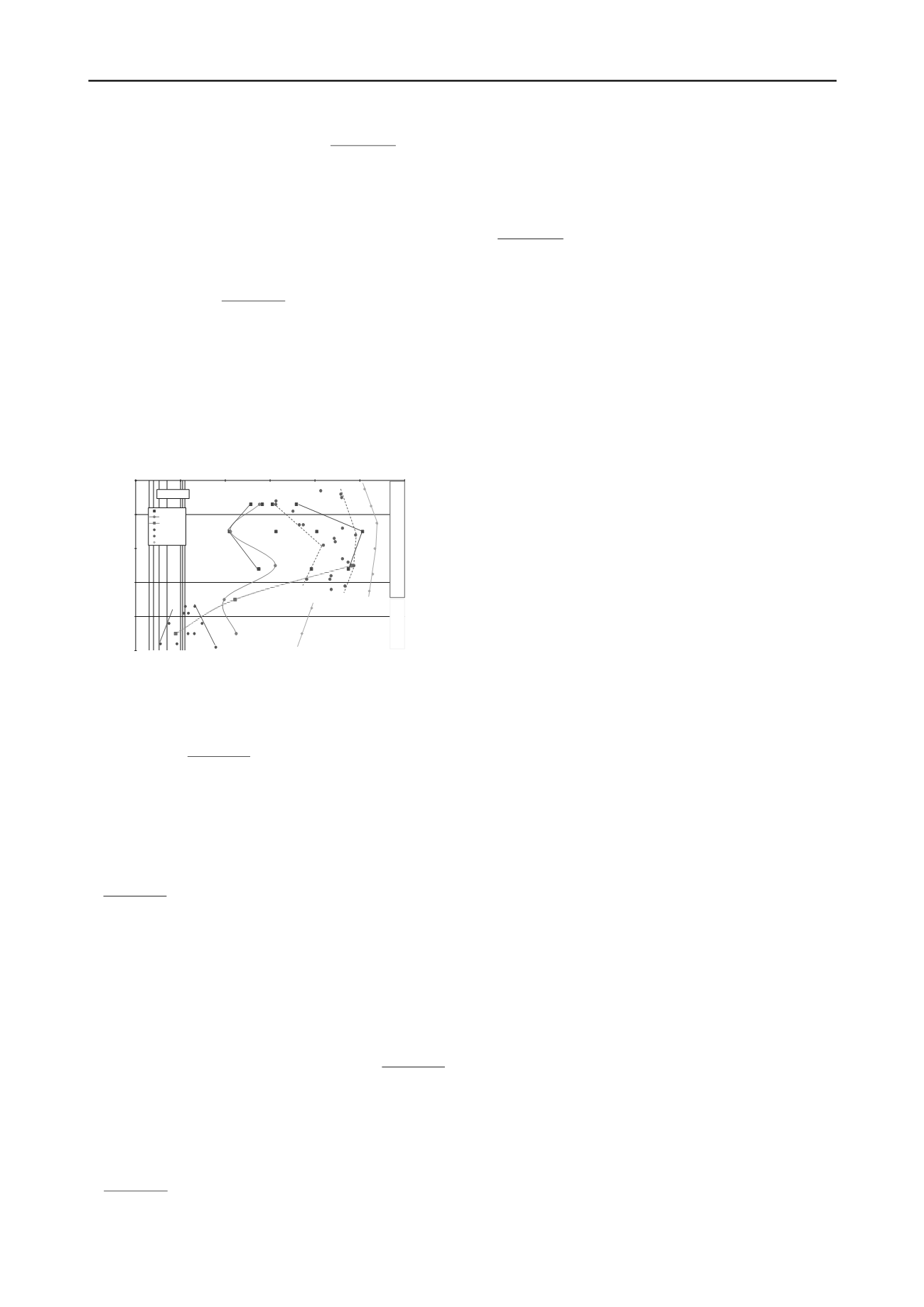
297
Technical Committee 101 - Session II /
Comité technique 101 - Session II
riverbanks and other earth structures. In paper 2572, Ge and
Yang developed indirect indentation method based on an upper
bound solution to a split tension failure in limit analysis and
performed a series of indentation tests on lightly cemented sand.
The limitation of this method is that a certain level of brittleness
of the specimen is required so that a split tension failure would
occur.
Coefficient of permeability can vary over an order of magnitude
depending on the testing method even in a relatively
homogeneous layer. In paper 2930, Nagy et al. determined and
compared permeability coefficients of a sandy silt and a silty
sand obtained by Khafagi probe, Menard probe, water filtration
method, constant head and falling head laboratory tests. As
shown in Fig. 7, the result showed higher scattering than
expected which has a relative error of one order of magnitude.
They suggested that it is not practical to use different
measurement methods in a single borehole because swapping
may result in measured findings showing greater differences
than normally accepted.
54+260 section
0
1
2
3
4
5
1,00E-08
1,00E-07
1,00E-06
1,00E-05
1,00E-04
1,00E-03
1,00E-02
Coefficientofpermeability k (m/s)
depth (m)
water filtration
Menard-probe
Khafagi-probe
constanthead test
falling head test
Hazen-equatation
Silty fine sand
Fine sandy silt
Groundwater notappeared
Fig. 7 Measured permeability coefficients from Nagy et al., paper 2930.
The reliable identification of dispersive soil is crucial but recent
testing suggests that many shortcomings related to testing of
dispersive soils have been overlooked during past routine
investigations. In paper 2976, a comparative study involving the
testing of three samples using one standard test, the SCS double
hydrometer test, was carried out. Maharaj and Paige-Green
observed that the variability of the results appears to be the
cause of many of the ambiguities and discrepancies in the
classification system and stressed the needs to develop optimum
procedure which is simple and have as few ambiguities as
possible so that no misinterpretation can occur.
In paper 3084, Imre et al. performed a statistical analysis based
on the results of two doctoral programs concerning the dry
density of sands (Kabai 1974, Lorincz, 1986). They showed that
the different dimension of the mold has some impact on the
measurement of minimum dry density and the e
max
test of the
German DIN may be biased because of the arching due to the
too small ratio of the diameter and height of the mold.
5. MISCELLANEOUS
Hardening due to thixotropy is important mechanism for the
very soft dredged soils with high water contents. In paper 2446,
Tanaka and Seng studied the thixotropic hardening by
measuring change in stiffness and strength with time using
bender element and vane shear tests. The effect of thixotropy
was found to be significant at around the liquid limit state and
the increment of shear modulus due to thixotropy appeared
noticeably higher than that in the secondary consolidation.
In paper 2494, Athanasopoulos et al. studied a 30m high slope
failure at the Xerolakka municipal solid waste landfill. Field
investigations including Lidar survey and shear wave velocity
measurements to characterize the MSW materials were
performed and numerical analysis was followed. The results
indicated that failure was caused by a combination of factors
including inappropriate waste disposal practices and compaction,
leachate and gas pressure generation and increased steepening
of the landfill slopes.
In paper 2705, Sarma and Sarma described the influence of
minerals on the elastic behaviour of cohesive soil. They
mentioned that the pattern is unique for cohesive soil and is
under the possible domination of the existence of a common
mineral and extent of its weathering process.
6. REFERENCES
Papers in the session of Laboratory Testing of Geomaterials II:
Strength Properties and Treated Soil (please see Appendix-
Table 1)
ADDITIONAL REFERENCES
Brooker E. W. and Ireland H.O. (1965). Earth pressure at rest related to
stress history.
Canadian geotechnical journal
, vol. 2, no. 1, pp.1-15
Berre T. and Bjerrum L. (1973). Shear strength of normally consolidated
clays.
Proc. 8
th
ICSMFE
, Moscow 1, pp.39-49.
Duncan, J.M. and Chang, C.M. (1970). Nonlinear analysis of stress and
strain in soils.
Journal of Soil Mechanics and Foundations
Division, ASCE
, 96(SM5), pp.1629-1653.
Kabai, I. (1974). The effect of grading on the compactibility of coarse
grained soils. Periodica Polytechnica.18 (4), pp.255-275.
Kim, D.H., Kim, Y.J., Lee, J.-S., Yun, T.S., (2010). Thermal and
electrical response of unsaturated hydrophilic and hydrophobic
granular materials.
Geotechnical Testing Journal
34(5), pp.562-570.
Ladd C.C., Foott R., Ishihara K., Schlosser F. and Poulos H.G. (1977).
Stress deformation and strength characteristics.
Proc. 9
th
ICSMFE
,
Tokyo 2, pp.421-494.
Lőrincz, J (1986). Grading entropy of soils Doctoral Thesis, Technical
Sciences, TU of Budapest.
Negussey, D. and Islam, M. S. (1994). Uniqueness of steady state and
liquefaction potential.
Can. Geotech. J.,
31(1), pp.132-139.
Lee J.Y., Ryu B.J., Yun T.S., Lee J.H. and Cho G.C. (2011). Review on
the gas hydrate development and production as a new energy
resource. KSCE, 15(4), pp.689-696


